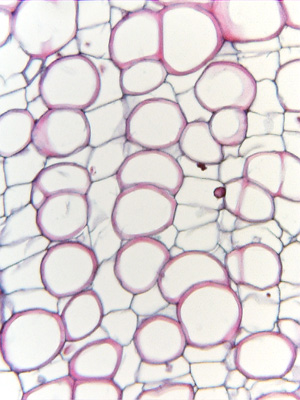|
[Home]
[Up]
[Intro: dicot wood]
[Intro: conifer wood]
[Intro: pine wood]
[Intro: annual rings]
[Pine tan s, ray]
[Pine xs, ray]
[Pine tan s, CBP]
[Pine rs, ray tracheids]
[Pine rs, ray]
[Fir rs, living rays]
[Manoxylic wood]
[Pine xs, CBP]
[CBP]
[Cambial record]
[Pine rs, tracheids]
[Dicot, primary ray]
[Living ray cells]
[Distorted rays]
[Uni-, multiseriate rays]
[Aggregate ray]
[Upright, procumbent cells]
[Sclerified ray]
[Cactus ray]
[Vessel radii]
[Solitary vessels]
[Clustered vessels]
[Vessels in chains]
[Ring, diffuse porous]
[Tyloses]
[Diffuse parenchyma]
[Banded parenchyma]
[Scanty paratracheal]
[Parenchymatous wood]
[Dimorphic wood 1]
[Dimorphic wood 2]
| |
 Chapter
15. Wood -- Secondary xylem. Chapter
15. Wood -- Secondary xylem.
The figures presented here were selected to illustrate aspects of the
cells and tissues of the wood of dicots and conifers. The legends were written
to complement the more complete discussion of secondary xylem presented in
Chapter 15 (pages 317 to 340) in the textbook Plant Anatomy by J. D.
Mauseth, published by Cummings & Hathaway.
For excellent photographs of whole trees, leaves and bark of most of the plants
illustrated here, see The Random House Book of Trees of North America and
Europe by Roger Phillips (1978).
Click here for a set of
links to the micrographs of this chapter.
Wood that both conducts
and stores water in the cactus Haageocereus australis.
|
 Chapter
15. Wood -- Secondary xylem.
Chapter
15. Wood -- Secondary xylem.